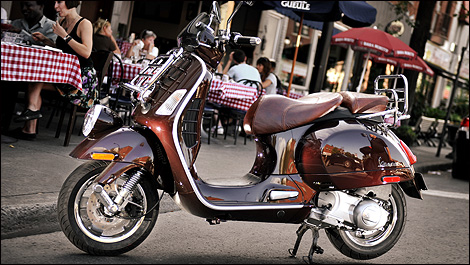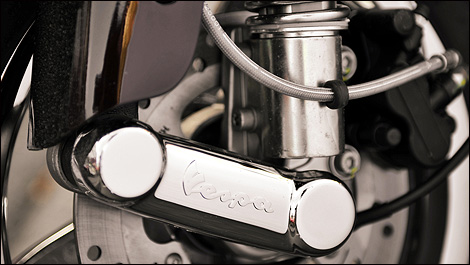In the true Italian tradition,
Vespa scooters set the style with a line of 1948-styled machines that are clearly the best looking machines on the market – based on the feedback from everyone we encountered during this test. And every other Vespa scooter test we have run in the past two years.
 |
| A beautiful machine, just right for "La Dolce Vita". (Photo: Matthieu Lambert/Moto123.com) |
Alas, life is not about style only, as reality has a nasty habit of intruding with the dreams and pointing out what really happens – good, bad or indifferent.
In the case of the Vespa GTV 300, the top of the line for this very Italian manufacturer, the good is very good indeed, while some other aspects of the machine make for a less-than-ideal package.
You like power? You got it here!
The 300’s drivetrain come off a definite winner here, with performance beyond its size and weight. The modern, liquid-cooled single calls upon 287cc to produce 22hp at 8250 rpm, and 16ft-lb of usable torque at 6250rpm. Only a near-Sporster 883 vibration at idle mars an excellent urban behaviour. In the same breath, the mechanically operated CVT has been tuned by the developers to make full and effective use of the torque from the engine. All of this happy combination makes for some lively performance figures as I found out during this test.
Solid chassis – suspension needs work
The steel chassis does not twist and oscillate under hard braking or cornering, nor when dealing with bad surfaces. You get a solid feedback about how happy and stable the machine is at all times. Braking and the standard ABS remain strong points on this as well as on other Vespa models.
The big fly in the ointment remains the virtual absence of compression and rebound damping at the front and the rear. This means bottoming at any bump or hole of any consequence. The front coil spring is wound to provide a softer stiffness in the first part of the travel then stiffen towards the end of the travel. In actual fact, the shock hits bottom while the coil is still in the soft mode, never reaching a stiffer mode to help absorb the bump and smooth out the ride.
 |
| The classic Vespa swingarm front suspension that hails back to the early 50s, combined with the beautiful chromed rim on this top-of-th-line model. (Photo: Matthieu Lambert/Moto123.com) |

